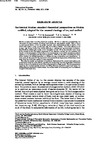Ice internal friction: Standard theoretical perspectives on friction codified, adapted for the unusual rheology of ice, and unified
| dc.contributor.author | Hatton, Daniel | |
| dc.contributor.author | Sammonds, PR | |
| dc.contributor.author | Feltham, DL | |
| dc.date.accessioned | 2013-04-22T15:30:23Z | |
| dc.date.available | 2013-04-22T15:30:23Z | |
| dc.date.issued | 2009-10-15 | |
| dc.identifier.issn | 0031-8086 | |
| dc.identifier.issn | 1478-6443 | |
| dc.identifier.other | 31 | |
| dc.identifier.uri | http://hdl.handle.net/10026.1/1453 | |
| dc.description | Sea ice rheology is a key uncertainty in oceanographic modelling. The ice contains faults, requiring understanding of the physics of friction on individual faults. In addition to geophysical implications, this has an important engineering application in prediction of loads on offshore structures in ice-infested waters. When sea ice impinges on a structure, a pair of faults often forms oblique to the bulk ice motion: subsequent deformation proceeds by sliding (Sanderson, 1988, Ice mechanics, Graham & Trotman, London). After undertaking towing-tank-scale friction experiments, it became clear that adaptation, codification and unification of available theories of ice internal friction were necessary. This paper contains that detailed micro-mechanical analysis. | |
| dc.description.abstract |
Sea ice contains flaws including frictional contacts. We aim to describe quantitatively the mechanics of those contacts, providing local physics for geophysical models. With a focus on the internal friction of ice, we review standard micro-mechanical models of friction. The solid's deformation under normal load may be ductile or elastic. The shear failure of the contact may be by ductile flow, brittle fracture, or melting and hydrodynamic lubrication. Combinations of these give a total of six rheological models. When the material under study is ice, several of the rheological parameters in the standard models are not constant, but depend on the temperature of the bulk, on the normal stress under which samples are pressed together, or on the sliding velocity and acceleration. This has the effect of making the shear stress required for sliding dependent on sliding velocity, acceleration, and temperature. In some cases, it also perturbs the exponent in the normal-stress dependence of that shear stress away from the value that applies to most materials. We unify the models by a principle of maximum displacement for normal deformation, and of minimum stress for shear failure, reducing the controversy over the mechanism of internal friction in ice to the choice of values of four parameters in a single model. The four parameters represent, for a typical asperity contact, the sliding distance required to expel melt-water, the sliding distance required to break contact, the normal strain in the asperity, and the thickness of any ductile shear zone. | |
| dc.format.extent | 2771-2799 | |
| dc.language | en | |
| dc.language.iso | en | |
| dc.publisher | Taylor & Francis | |
| dc.title | Ice internal friction: Standard theoretical perspectives on friction codified, adapted for the unusual rheology of ice, and unified | |
| dc.type | journal-article | |
| dc.type | Article | |
| plymouth.issue | 31 | |
| plymouth.volume | 89 | |
| plymouth.publication-status | Published | |
| plymouth.journal | Philosophical Magazine | |
| dc.identifier.doi | 10.1080/14786430903113769 | |
| plymouth.organisational-group | /Plymouth | |
| plymouth.organisational-group | /Plymouth/Faculty of Science and Engineering | |
| plymouth.organisational-group | /Plymouth/Faculty of Science and Engineering/School of Engineering, Computing and Mathematics | |
| plymouth.organisational-group | /Plymouth/REF 2021 Researchers by UoA | |
| plymouth.organisational-group | /Plymouth/REF 2021 Researchers by UoA/UoA12 Engineering | |
| dcterms.dateAccepted | 2009-06-11 | |
| dc.identifier.eissn | 1478-6443 | |
| rioxxterms.versionofrecord | 10.1080/14786430903113769 | |
| rioxxterms.licenseref.uri | http://www.rioxx.net/licenses/all-rights-reserved | |
| rioxxterms.type | Journal Article/Review |


